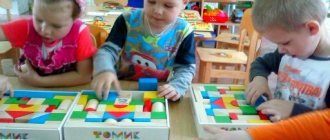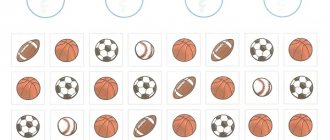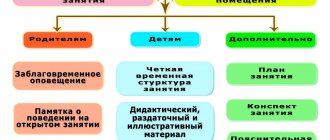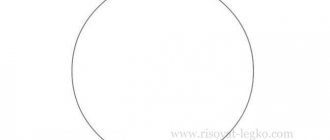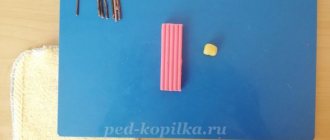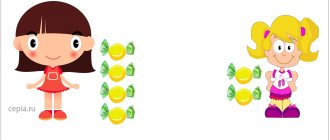Features of an open lesson in mathematics in the middle group of preschool educational institutions
Open viewing of FEMP is an effective form of organizing the pedagogical process in kindergarten. Being one of the varieties of mathematical classes, this educational activity also solves educational, developmental and educational problems.
Educational objectives in the middle group are related to the content of the program. This is counting within five, comparing objects by size (by two characteristics at once), building a serial series, getting to know new geometric shapes (rectangle), developing orientation in space, expanding time concepts. In this case, an open mathematical lesson usually touches on several of these problems at once.
The developmental tasks of an open lesson are associated with the development of the intellectual sphere of a preschooler - the processes of thinking, attention, perseverance, and the development of correct speech. At the same time, the work is organized in such a way that the child acts as a leader, takes an active position, and reveals his abilities to the maximum.
Each open mathematical lesson necessarily carries an educational value. The teacher must select a topic that will contribute to the development of positive moral qualities in the preschooler, for example, love for his native land, the desire to treat plants and animals with care, etc.
When thinking through the content and structure of an open mathematical lesson in the middle group, the teacher should focus on the following important aspects.
- Meaningful. The open viewing should become a source of innovative experience for colleagues, touching on current problems of modern methods of preschool education, as well as child psychology. An innovative approach can be expressed in the very content of visual or handout material, or in some interesting methodological technique, the use of ICT, unusual organization of space, etc. After all, showing traditional mathematical activities will not contribute to the professional growth of the specialists present.
- Social. During an open lesson, the teacher creates a situation of success for preschoolers. To achieve this, praise, encouragement, and giving the child the right to make mistakes are actively used. The teacher demonstrates the strengths of children, revealing their thinking and creative abilities.
- Pragmatic. Open viewings of FEMP are an additional incentive for cognitive activity for middle group students. They enjoy playful activities (which always accompany such events) and attention from adults.
In an open lesson with children of the fifth year of life, the following is required:
- clear organization and planning of each stage of educational activity (unlike, for example, mathematical entertainment, where the script allows improvisation);
- a mandatory intriguing start to the lesson, which will become a motivating moment for children;
- coherence and logic of the plot (usually a journey is chosen, helping a fairy-tale hero, achieving a common useful goal);
- individual approach to children (the mental and somatic development of children is different, for example, someone else has speech problems);
- original visual aids that invited teachers will be able to produce and use in their practice;
- the teacher's friendly tone, appropriate facial expressions and gestures.
In order for the open event to be successful, all planned goals are realized, the topic is revealed, the teacher needs to prepare a detailed summary (which he coordinates with the preschool educational institution methodologist). Every action of the teacher is written down there: introductory remarks, assignments, questions, comments on them during the lesson, expected answers from children, etc.
As for organizational aspects, an open mathematical lesson in the middle group is conducted without “rehearsal” and has the usual duration for this age (20 minutes). Although children of the fifth year of life are no longer babies who can cry when they see strangers, you should still psychologically prepare the children for the event, and also inform their parents about it in advance.
Guests of open viewing are always provided with workstations behind preschoolers (so that they do not distract children from cognitive activity).
At the beginning of the lesson, the teacher draws the children’s attention to the adults present and offers to say hello to them - then the kids will not look at them during the activity.
Sometimes parents are also invited to open screenings - this is useful for strengthening family relationships and gives mothers and fathers a real idea of the level of knowledge and skills of their children. In the middle group, this can be practiced, but with caution, because there are always children who can get up and go to their mother during class. In this case, work with the rest of the children should continue as usual.
Methodology for conducting an open lesson in mathematics in the middle group (structure and forms of work)
Open viewing, being a type of educational activity, has a certain structure.
- Organization and motivational beginning of a lesson that stimulates preschoolers to cognitive activity (2–3 minutes).
- Main stage. Completing tasks that reinforce certain mathematical concepts, since during an open demonstration, an explanation of new material is usually not given.
- The final stage. Summing up (2-3 minutes): the teacher asks preschoolers to share their impressions of the event, talk about what they liked most and what caused difficulties.
During an open lesson, the teacher must alternate different forms of children's activities. This will enliven the course of the lesson and allow each child to reveal the abilities. The most appropriate would be a combination of group and subgroup types.
- Collective activities: frontal survey;
- didactic games;
- physical education minutes;
- finger games;
- outdoor games with mathematical content.
Individual work is an important part of an open mathematics lesson
Project “Journey to the Land of Entertaining Mathematics” in the middle group
Olga Mukhlygina
Project “Journey to the Land of Entertaining Mathematics” in the middle group
Relevance.
The problem of revealing the abilities and inclinations of mathematical thinking of preschool children in modern life is becoming increasingly important. This is explained, first of all, by the rapid development of science related to mathematics and its penetration into various fields of knowledge.
Modern society today needs people who are intellectually courageous, independent, original thinkers, creative, and able to make non-standard decisions. The education system should help ensure that the child receives such knowledge, skills and abilities that would allow him to successfully adapt to new conditions of society. In this regard, both parents and teachers are always concerned with the question of how to ensure the full development of a child in preschool age, how to properly prepare him for school and socialization in society.
And, of course, teaching preschoolers the basics of mathematics is currently given an important place. This is caused by a number of reasons: the beginning of schooling at the age of six, the abundance of information received by the child, increased attention to computerization, the desire to make the learning process more intensive, the desire of parents to In connection with this, as early as possible, teach the child to recognize numbers, count, and solve problems.
It is known that a preschool child is amazingly active in learning about his surroundings, and his mathematics Gradually, ideas about objects, their purpose and properties, size and number, and shape are formed. I want to enlarge everything, divide it, count it, measure it. A child’s horizons are formed first on the basis of what caught his eye, attracted attention, was able to see in adults, as well as what he managed to come into contact with and experiment with. Then the horizons expand: the child assimilates what they talk about, read about; he makes his own guesses and fantasizes.
Mathematics for children is most important in terms of memory development and further assimilation of the information content of education. Therefore, it is very important to have the right approach to organizing the learning process for preschoolers. For children of this age, play is the leading activity. This means that the learning process in kindergarten should be of a playful nature, otherwise strict classes will become boring for the child, and he will not want to return to them. Game material should be varied, changed frequently and supplemented with new content.
Avoiding boredom in the classroom, involving all children in the gaming cognitive process, and the ability to make it truly exciting - this is the main task of the teacher in solving the problem of revealing the abilities and inclinations of mathematical thinking in preschool children. After all, this is what contributes to the formation and improvement of the child’s intellectual abilities, the logic of thought, reasoning and action, the flexibility of the thought process, ingenuity and ingenuity, and the development of creative thinking.
Contingent of participants - teacher and students of the middle group of MBDOU Kindergarten No. 44 “Bee”
.
Goals and objectives of the project .
Project goals :
— increasing interest in mathematics among children of the middle group by creating conditions for research activities, developing creative abilities, skills and abilities;
— formation and development of the simplest logical structure of thinking and mathematical concepts .
Tasks:
— develop interest in solving cognitive, creative problems, in a variety of intellectual activities;
- develop imaginative and logical thinking, the ability to perceive and display, compare, generalize, classify, modify, etc.;
- consolidate the names of geometric shapes and some of their properties;
- develop combinatorial abilities by combining color and shape, development of creative imagination, memory;
- teach how to classify geometric shapes according to different criteria: color, size, shape;
— teach to correlate the shapes of objects with geometric figures.
Contents of the project , its main stages and implementation mechanisms.
The implementation of the project involves joint organized play activities, games in a subject-developmental environment , experimentation with measures of quantity in order to master the program for the formation of elementary mathematical concepts in preschoolers.
Project implementation stages :
Stage 1 - analytical.
Objectives of the stage: analysis of the situation; determination of its main goals: the formation of ideas about geometric shapes in children of middle preschool age.
Stage 2 - organizational.
Objectives of the stage: drawing up a plan for the teacher to work with children to form ideas about geometric shapes through research activities.
Stage 3 - practical activity.
Objectives of the stage: the formation of ideas about geometric figures in children of middle preschool age, through research activities.
Stage 4 - final.
Objectives of the stage: generalization of experience and determination of the result of the teacher’s practical activities.
project implementation :
— didactic exercises and games;
- application;
- outdoor games aimed at developing ideas about the shape of objects and geometric figures.
1. Educational game “Treats for bear cubs”
Target. Development of perception of color, shape and size in children of the middle group .
The child is given tasks aimed at differentiating characteristics of color, size, and shape. Beforehand, the children are given bear toys, cards with signs and symbols of properties; Dyenesha blocks: plates of different colors.
Two bear cubs came to visit; They have a sweet tooth and love cookies of different shapes and different colors. Educator: But I have circles and squares of different colors and it’s easy for me to turn them into cookies for the bears, and the girls and boys will help me with this. Girls will take round cookies, and boys will take square ones. It is proposed to find similarities and differences using visual methods.
2. Riddle game “Wonderful bag”
Target. Development of memory, imagination, perception of the shape of an object.
The bag contains round, square, rectangular objects, 2 counting sticks: short and long (for example, orange and light green)
. The child feels the object, naming it. The rest of the children check the correctness of the task.
The teacher encourages those children who identify and name several features, for example: thin, round, indicate the color of an object. He draws the attention of all other children to such answers.
3. Travel game “Find your house”
Target. Development of children's ideas about geometric shapes.
Children are given various geometric shapes that differ in color and size. In three hoops in different corners of the room on the floor lie a circle, a square and a triangle.
“All the circles live in this house,” says the teacher, “all the squares live in this house, and all the triangles live in this house.” When everyone has found their houses, the children are invited to “take a walk”
: run around
the group .
At the teacher’s signal, everyone finds their house, comparing their geometric figure with the one in the house. The game is repeated several times, with the teacher changing the houses each time. 4. Application “Animals”
from geometric shapes.
Goal: to consolidate the ability to distinguish geometric shapes: rectangle, triangle, square, circle, oval.
The ability of children to classify and combine geometric shapes, to correlate the shapes of objects and animals with geometric shapes is tested.
Classes are held once a week, lasting 20 minutes.
Individual work, if necessary, is carried out additionally once a week for no more than 10 minutes.
Children in the middle group are able to quite easily learn the names of the shapes of objects: circle, oval, square, rectangle, triangle. It is especially important that the geometric figure acts as a model for the child (a standard against which the shape of the object can be determined.
This is best achieved by using various objects at hand: a saucer, a button, a ball (round)
;
flag, carrot (triangular)
;
scarf, lotto card, building material (square)
;
egg, cucumber (oval)
. By exploring these objects, the child learns to correlate geometric shapes with the world around him.
Expected and obtained results.
Expected results of the project :
— Increasing the level of knowledge about geometric shapes, their elements (vertices, angles, sides)
and some of their properties.
- the ability to recognize figures regardless of their spatial position , depict, arrange on a plane, arrange by size, classify, group by color , shape, size.
- the ability to compose figures from parts and break them into parts, to construct figures according to verbal descriptions and listing their characteristic properties; create thematic compositions from figures according to your own ideas.
Results:
As a result of the work carried out with children, the goal set earlier was achieved.
Step-by-step training and correctly selected tasks and game material , conditions created for the implementation of acquired knowledge contribute to the fact that the development of the foundations of logical thinking occurs more effectively.
The correct selection of tasks and exercises help children in the formation of cognitive processes, namely the formation of logical thinking.
The implementation of the development of logical thinking depends on the characteristics and nature of the developmental environment in the group and home in which the child is located, on the teacher’s organization of the process of learning mathematical relationships and dependencies.
List of sources and literature used
1.https://doshvozrast.ru/metodich/pedoput72.htm
2.https://forum.schoolpress.ru/article/57/656
3.https://dohcolonoc.ru/proektnaya-deyatelnost-v-detskom-sadu/6171-proekt-volshebnaya-strana-matematika.html
4.studopedia.ru
5.https://raguda.ru/ds/programmy-po-matematicheskomu-razvitiju-detej.html
6. Beloshistaya A.V. Development of logical thinking in preschoolers. - M.: Vlados, 2013.
7. Zhukova R. A. Mathematics . Middle group . Development of lessons. - Volgograd: Corypheus, 2007.
8. Kolesnikova U.V. Mathematics for children 4-5 years old . — M. TC Sfera, 2013.
9. Minkevich L.V. Mathematics in kindergarten . Middle group . - M.: Scriptorium 2003, 2013.
10. Kuvaeva N. L., Miklyaeva Yu. V. Notes for classes in mathematics . Complex and integrated classes in preschool educational institutions. - M.: Iris Press, 2008.
11. Novikova V. P., Tikhonova L. I. Educational games and activities with Cuisenaire sticks for children 3-7 years old. - M.: Mosaic-Sintez, 2013.
12. Pomoraeva I. A., Pozina V. A. Formation of elementary mathematical concepts (4-5 years)
.
Middle group . – M.: Mosaika-Sintez, 2014.
